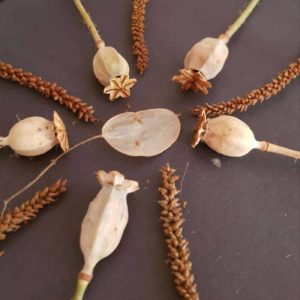I was recently looking at the Benedictus, otherwise known as the words Zechariah says on the birth of his son, John the Baptist in Luke 1:67-79. It’s a powerful passage, although not as well-known as Mary’s song a few verses earlier in the chapter. As I looked at it, I started to see connections with various Old Testament passage.
When I looked into it further, I discovered that those 13 verses contain at least 19 references to Old Testament passages. When we read the Bible, especially songs or prophetic words spoken by people, we might assume that their words are pure and fresh and straight from heaven, but there is often much ‘borrowing’ and connecting of ancient words into a new situation.
What I began to suspect was that Zechariah’s work as a priest had led to an extensive knowledge and understanding of what we call the Old Testament. In what was probably the peak of this priestly career, he was offering prayers in the Holy Place in the Temple in Jerusalem when he had an angelic encounter, followed by nine months of mutism before the birth of a son in his extreme old age. This prophecy is the time he has spoken for nine months and his words bring together ancient words in a brand-new way, making them familiar and rooted in his tradition as well as deeply prophetic about the future.
It might be said that life is all about making connections – connections between people, objects, places and abstract concepts.
One of my most favourite ways to see connections being made is through playing with loose parts. This is essentially open-ended play with a stack of things which can be moved and manipulated in a multitude of ways. It’s the easiest Invitation to Play that I know, and I’ve been using them with my children since they were tinies.
It started with a basket of brushes I collect from all rooms of the house – every type of brush I could find, except the loo brush! My 6 month old LOVED it and chose a bright red IKEA dish brush as her carry around and take out with me toy!
Now they’re a bit older (7 and 9), the loose parts can be smaller and more fragile without worrying they will be eaten or broken (or both!), but the essence is the same – they get to play with the pieces in whatever way they choose, making connections between elements to create new things.
I will often make a loose parts Invitation to Play by putting a collection of loose parts in a wooden tray or basket in an area set up for them to explore. Making the area clear for working and beautiful to look at is all part of my joy in doing it, as well as helpful to their use of the space. As is said in Reggio Emilia circles, “the environment is the third teacher”.
It’s always interesting to see what they do, but never more so than when we’ve just started exploring a Bible story.
The Bible is full of interconnected stories. This isn’t immediately apparent when we read them separately, which is especially true for young children who are often introduced to Bible stories in individual, bitesize pieces. However, when they are given in an environment which allows playful exploration, coupled with open-ended questions such as ‘I wonder what this story reminds you of’, the depth of connections quickly become apparent. The very careful use of words in Godly Play stories also help to develop this in a much more subtle way than in Bible story books where everything is linked back to, for example, the story of Jesus. The use of the term ‘people of God’ when talking about any of God’s people helps us to see themes in the ways God relate to his people and in what his people do.
When we use the same physical items to tell different stories in the Bible, this has the same effect. When the ‘people of God’ used in the story of the crossing of the desert in the stories of Abraham, Isaac and Jacob are used in the story of the crossing of the Red Sea, the parallels and connections are obvious. It even helps to have the same mat you roll out to play the story on, or doing it in the same space. The continuity of context helps create the connections.
This path of making connections is more than intellectually interesting, although that has great worth in itself. It might be the beginning of seeing themes in the overarching story of God’s relationship with his people throughout the Bible, seeing themes of justice and relationship, of family, connection, or holiness.
By making connections between different groups of God’s people we can also begin to make connections to ourselves. When we put people in the sand and think about how they might have experienced the crossing of the Red Sea, it is somehow easier to imagine ourselves as one of these characters. Even exploring the different roles of the characters in the Christmas story allows us to see how we relate to the Christ child born in a manger. I remember once after telling the Christmas story with a group of families, I asked the question: I wonder where you might be in this story, and one Dad stood up who did not consider himself to be a Christian, but came to support his family. He said he was like the cow who was in the shed, watching the action but not part of it. I found it really wonderful that he felt comfortable to share, and that this was his reflection about himself in that moment. My prayer is that the connection he made to the story will continue to grow.
Using loose parts is as easy as setting things out and saying giving permission to play, and Autumn is the perfect time to make a collection of FREE loose parts! Over the next few months, the trees shower us with wonderful gifts of leaves, acorns, beech nut shells and sycamore ‘wings’. They can used both for process creations (ones which you make then put all the pieces back) and more traditional art such as collages and models. We’ve also used loose parts from nature to create people and angels to tell the Christmas story. A cool glue gun is a great tool for this, as it lends itself to quick attachments.
One way to collect them together is using a cutlery tray. I have a wooden one with a handle on it which I found at a charity shop which does the job of keeping a selection of loose parts in separate compartments but all in the same area. It also makes tidying up really easy, and of course, if you use all natural loose parts, you can just compost them once you’re done with them!
I have found loose parts a great way to introduce play as a response to a Bible story at home, in childrens’ groups, and even in all-age or intergenerational services, as adults can really enjoy this simple and very tactile way of thinking. I’ve often heard from adults who try it for the first time that they were reticent to begin, but once they got started, they found their hands just did the work and let their mind and heart connect with the Bible passage in new and creative ways.
What will you collect and play with?
Each issue of the Faith at home mini-mag has an activity where families can play with loose parts in an open-ended response to a Bible verse or story, and each activity box comes with a selection of materials to use as you choose.

